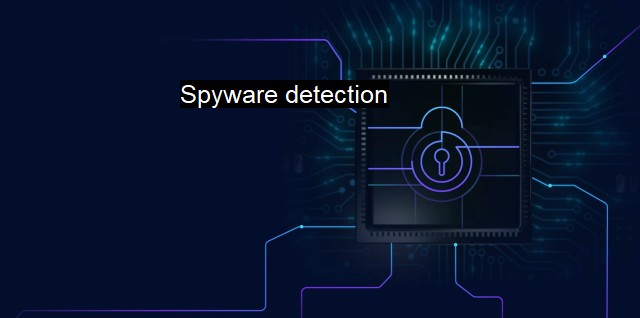What is Spyware detection?
Defending Business Assets: The Vital Role of Spyware Detection in Cybersecurity and Antivirus Protection
Spyware detection is a crucial aspect of cybersecurity that involves identifying and removing malicious software, known, as Spyware, from a system. Spyware is a type of malware that secretly monitors the computer activities of users and collects sensitive personal information without their knowledge or consent. This information can then be used for various unethical purposes ranging from illegally obtaining financial or personal details to intrusive advertising and even undermining national security by targeting entire information infrastructures of countries.The malicious nature of spyware and its potential to breach privacy and security protocols make spyware detection fundamental in the realm of cybersecurity. Spyware operates clandestinely, often unnoticed in the background of an operating system, making its activities invisible to the everyday user. It’s subtly disruptive, gradually infiltrating the crevices of a system and sneakily eavesdropping on user activity. As a result, detecting spyware requires specific techniques and specialized programs, typically offered by antivirus software vendors.
The first step in spyware detection is real-time monitoring, whereby an antivirus software scrutinizes the ongoing activities on a system to ascertain any anomalous or suspicious patterns. Such patterns are often indicators of potential spyware and are therefore automatically flagged or halted by the software, thwarting any possible infection.
Another common feature of spyware detection is the utilization of a robust database known as "signatures" of known spyware. This database comprises digital footprints or markers that distinguish each spyware type and are regularly updated to ensure they can detect even the latest forms of spyware. When the antivirus program scans a system, it matches the data on the system with spyware definitions stored in the database and flags those that bear similarities.
Spyware detection also heavily employs heuristic analysis. The analysis operates on the premise that not all malicious programs can be known ahead of time, especially in the rapidly evolving cyberspace where new threats are crafted daily. Therefore, heuristic analysis uses an algorithmic approach to analyse the behaviour of software or files and identifies those that behave typically to spyware, in spite of not being confirmed as spyware in the included database.
These detection methods form the bedrock for spyware elimination or quarantine, followed by a swift repair of the adversely affected system areas. prevention is better than cure; hence various proactive measures can be taken to thwart any contact of the system with spyware. Measures include practising safe surfing and downloading habits, updating systems and software programs regularly, and educating oneself and others about phishing scams and other social engineering techniques commonly employed by perpetrators.
Yet, the increasing cunning and complexity of spyware have created a cat and mouse game, placing immense pressure on antivirus vendors to keep their spyware database and detection techniques continually updated to outsmart new threats. constantly evolving Artificial Intelligence (AI) and Machine Learning (ML) technologies have the potential to augment traditional detection by automating pattern recognition and enhancing swift response to detected threats.
Spyware detection is a pivotal part of cybersecurity and involves identifying and eliminating invasive software known as spyware. The stealthiness of spyware poses detection difficulties and calls for diverse, sophisticated techniques and algorithms, including real-time monitoring, signature database, and heuristic analysis, among others. As cyber threats continue to evolve, so must the innovation, vigilance, and educational endeavours dedicated to battling the ever-looming dark cloud of spyware cyber-attacks.

Spyware detection FAQs
What is spyware detection and why is it important in cybersecurity?
Spyware detection is the process of identifying and removing spyware from a computer system. Spyware is a type of malware that is designed to gather information from a system without the user's knowledge or consent. This information can include browsing habits, passwords, and personal data. Detecting spyware is essential in cybersecurity as it can compromise the security and privacy of the user's data.What are the common signs of a spyware infection on a computer system?
The common signs of a spyware infection on a computer system include a slow system performance, frequent crashes, unwanted pop-up ads, changes in browser settings, unfamiliar toolbars, and programs that start automatically. If you notice any of these signs, it is recommended to run a spyware scan on your system immediately.What are the different methods of spyware detection?
There are several methods of spyware detection, including signature-based detection, behavior-based detection, and heuristic detection. Signature-based detection involves comparing the code of a program to a database of known spyware signatures. Behavior-based detection monitors the system's behavior for any suspicious activities that resemble spyware behavior. Heuristic detection involves analyzing the behavior of a program and identifying any abnormal or suspicious activity.How can I prevent spyware infections on my computer system?
To prevent spyware infections on your computer system, it is recommended that you have an up-to-date antivirus program and firewall installed. Additionally, avoid downloading software from untrusted sources, clicking on links or pop-up ads from unknown sources, and opening email attachments from unknown senders. Also, keep your operating system and software up-to-date with the latest security patches and updates.| | A | | | B | | | C | | | D | | | E | | | F | | | G | | | H | | | I | | | J | | | K | | | L | | | M | |
| | N | | | O | | | P | | | Q | | | R | | | S | | | T | | | U | | | V | | | W | | | X | | | Y | | | Z | |
| | 1 | | | 2 | | | 3 | | | 4 | | | 7 | | | 8 | | |||||||